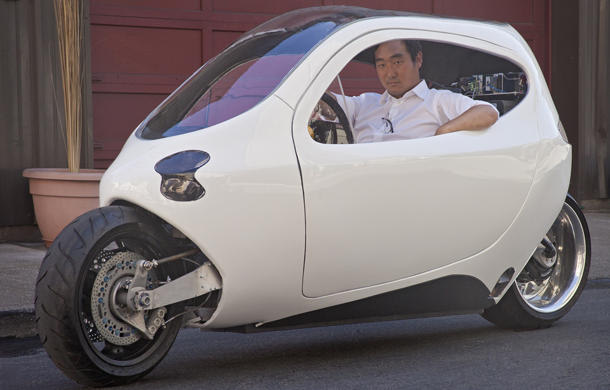The LIT C1 bets the future of driving on a gyro-balanced two-wheeler
In a nondescript building on the grittier side of downtown San Francisco, the future of personal transportation is being born — at least according to this baby's Dr. Frankenstein, an affable 33-year-old named Daniel Kim. Sitting in the glare of a few spotlights is the LIT Motors C1, an enclosed two-wheeler that combines the flexibility and fuel efficiency of an electric motorcycle with the safety, comfort and storage space of a small automobile.
But there's a true innovation at work: the C1 has two powerful on-board gyroscopes generating 1,300 ft-lbs of torque that keep the two-wheeler upright even when struck by a larger vehicle. "It would take an elephant to knock this thing over," says Kim.
To prove the point, Kim has lashed the C1 to the bumper of his completely rebuilt Land Rover (a pet project of the Portland, Ore., native the preceded a degree at Rhode Island School of Design) and stepped on the gas. The C1 got slightly airborne, but never fell over.
"I think (LIT has) a chance of making it for two reasons," says Kim. "One, after traveling the world I saw that a huge percentage of motorists travel alone, and in the developing world most of them are on two wheels. And two, I don't have to hire anyone to design, because I do it all myself. I like to think I'm de-risking the company that way."
In fact, Kim's high-tech titanium glasses, ring and overcoat were all whimsical projects of this inveterate tinkerer who, like Steve Jobs, attended but then dropped out of Reed College before going on to RISD. "I should have graduated from Reed just so people would stop making that comparison," Kim says with a smile.

The C1 was born out of Kim's desire to become the next big deal in transportation, a moment that's still more than a year away. The dozen-staffer start-up company currently has one mock-up (a sleek white bubble sitting on massive tires) to show prospective customers and investors, and one raw but functioning prototype. LIT wants to raise $5 million to $10 million to develop its proprietary software and create a true beta version of the C1 that would then lead to a production run of 1,000 units in 2014. Kim says Silicon Valley venture capital firms and auto industry players have made overtures.
And he may try a new Kickstarter campaign.
The C1 will have a 200-mile range, do zero-to-60 mph in 6 seconds with a 120-mph top speed, and initially cost around $24,000, with the price falling to $19,000 after tax credits. LIT's chief marketing officer Ryan James says LIT wants to scale production so the price drops to around $12,000 after credits.
James says LIT's target customers include people who already ride motorcycles but are concerned about safety, don't like dressing up in bulky riding gear and crave more storage space. But an ever larger market "would be people who might have never ridden a motorcycle but are looking for a solution to their commuting headache," he says.
Adds Kim: "A company like (electric car manufacturer) Tesla has done amazing things to make the alternatively powered vehicle sexy, but what we're making might fit into more people's lives." He cites not only studies that indicate that more than half of daily commuters drive alone, but also notes that increasing congestion and parking issues could be mitigated by C1 ownership. Because the machine would be classified by the U.S. Department of Transportation as a motorcycle it qualifies for lane-splitting, carpool lanes and motorcycle parking areas.
There's also another potential market for Kim's creation, as shown by a local California Highway Patrol officer who recently was poking around the C1. Kim wondered whether his machine would appeal to law enforcement, and the response was positive. "The safety (to the C1 driver) and the fact that you're out of the elements in that bubble seemed very appealing to him," says Kim.



No comments:
Post a Comment